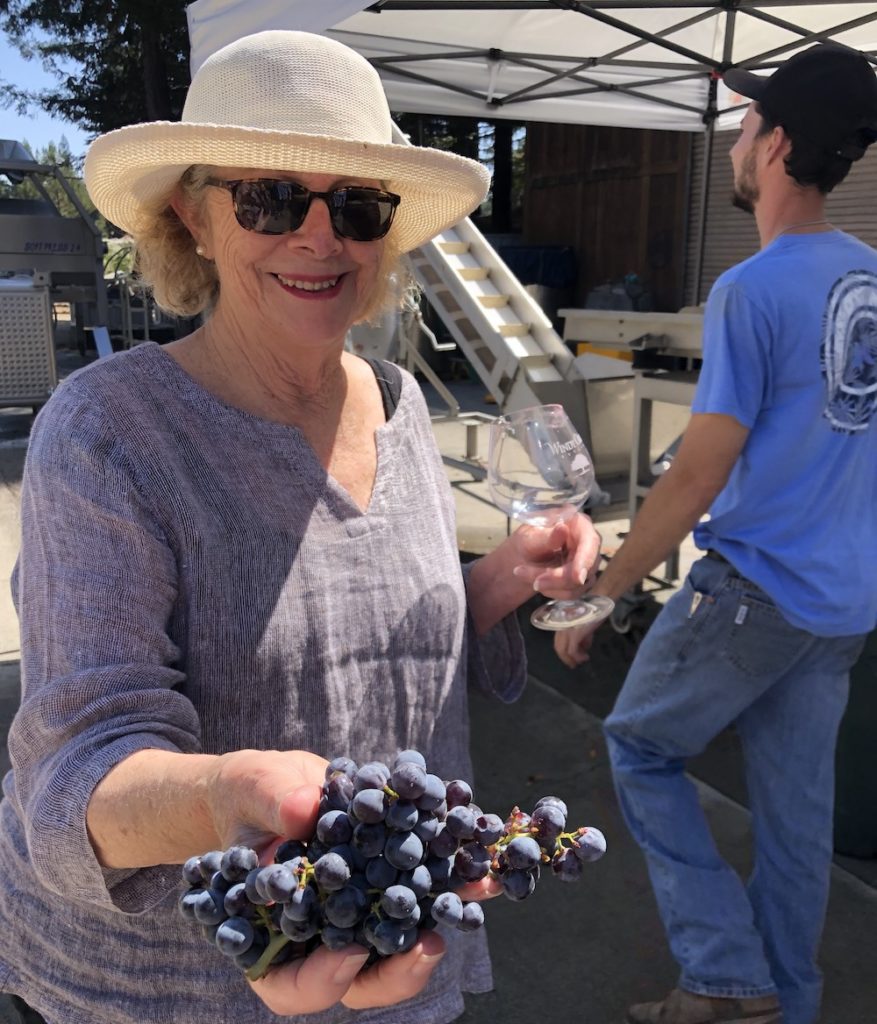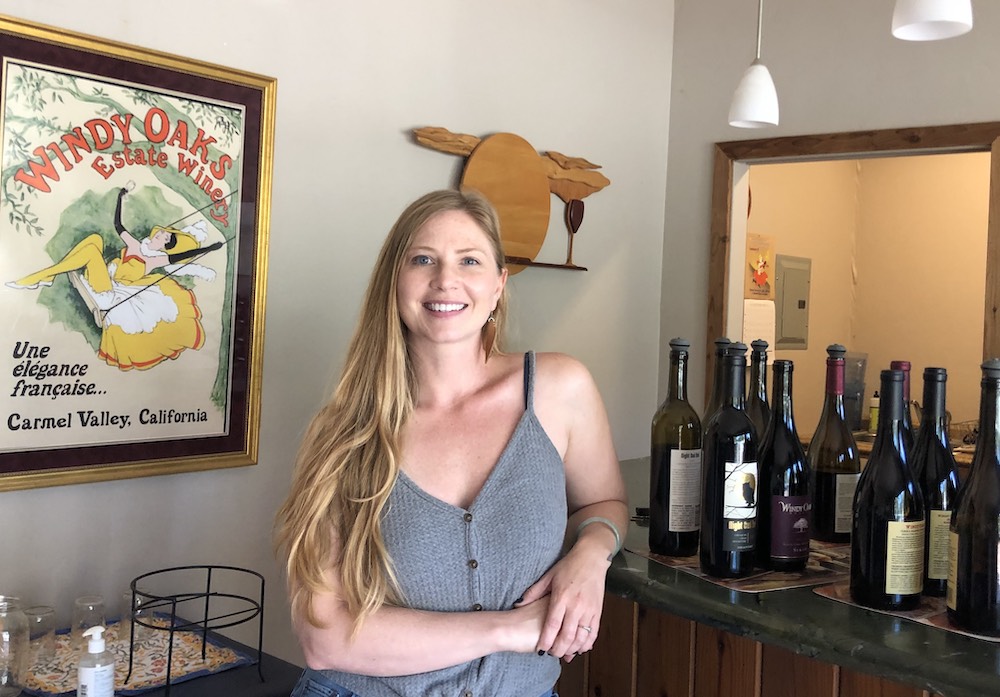
September 13, 2022 – Dappled clouds made a wedgewood blue sky look like the edges of a Maxwell Parrish painting as we arrived at Windy Oaks, the crushpad alive with activity. Bins of old vine Mourvedre from Rodnick Vineyard in Chalone sat waiting to be turned into the ethereal elixir that is wine.
While owner Judy Schultze greeted us, her younger son, winemaker Spencer Schultze, deftly maneuvered the forklift to grab another bin and dump it high into the sorter-destemmer. This is a total hands-on effort for the whole family, including Spencer’s wife Jamie, who works the estate tasting room on Mondays.
Judy and Jim Schultze started this venture back in 1996 with the intention of recreating a bit of their beloved Burgundy in California. Starting with a few acres of Pinot Noir, they added more, and more, and now have close to 27 acres, with an exciting assortment of clones, including Pommard, 667, 777 (Judy’s Block), Pommard 5 and 2A (aka Wadenswil), which makes up Henry’s Block.

Overlooking the Monterey Bay is a large planting of what they call SBC, Special Burgundy Clone, which came from dormant cuttings plucked from a vineyard in Domain Romanée Conti that they particularly admired back in 1999. “We wrapped them in damp paper towels and when we got home, put them in water on the windowsill until the came alive,” Judy explained. To see the proliferation of those vines now is to appreciate the propagative and feisty nature of grapevines. The vineyard from which they originated in France survived phylloxera, one of the few to do so, making them a very precious heritage.
Windy Oaks also has a small block of Syrah that produces a wonderfully spicy, silky smooth cool climate example of the grape, with a serious dollop of pepper on the finish.
As we sipped on the 2018 One-Acre Estate Chardonnay, Judy explained that she had to advocate for something else besides Pinot Noir in the vineyard. “Jim wanted all Pinot Noir, but I pointed out that Chardonnay is one of the great grapes of Burgundy. So, we have a one acre block of Chardonnay.”
We’re glad she did, as the aromas of creamy lemon shortbread are matched neatly by the pretty pear and peach tart flavors on the palate. Barrel-fermented, it finishes with a richness of baked golden apple galette.

We were sitting at the edge of it: the Chardonnay is part of the east-facing portion of the vineyard that races down from the ridge towards the crush pad. Just try walking up the hill towards the ridgetop and you get a total appreciation for the challenges of farming here.
Which is why Jim Schultze is always researching new methods to help produce better fruit and more magnificent wines. He has a special heat treatment machine from Germany—it’s like a giant blower that is towed by a tractor through the vineyard, emitting hot air at about 300 degrees—that helps mitigate the impacts of mildew and destroys botrytis, reducing the need to do labor intensive spraying to achieve the same results. This is a high disease pressure area, due to the vineyard’s proximity to the ocean and its life-giving fog, which also happens to give life to mildew. “We only did 4 sprays this year,” Jim told us. “The other benefit of heat treatment is that besides killing mildew spores, it also eliminates pests. We got rid of leaf blight and mealy bugs. And, it helps improve fruit set as well, so it’s well worth the investment of $50,000. Scheid has five of them, each of which handles 200 acres. They get an additional 100 tons of fruit per vineyard area, which is an immediate payback!”
Jim also mentions that they do run the occasional risk of rain, due to what he believes is the longest hang time of any Pinot Noir vineyard in California, with flowering March and harvest not happening until late October, When that has occurred, he’s been able to dry off the bunches with the magic heat machine.
Windy Oaks, though, is tiny, at about 5,000 cases. Of that, there are 18 different Pinot Noir SKUs, plus at least three Chardonnays (in addition to the estate, they used to make a Miller Vineyard designate, and also produce an Escolle Vineyard Chard from Scott Caraccioli’s vineyard in the Santa Lucia Highlands), a GSM, a Mourvedre, Viognier and a Pinot Blanc from Rodnick Vineyard in Chalone, plus sparkling Albarino and a barrel-fermented Sauv Blanc from Remde Vineyard.

It’s hard to believe how much they’ve grown since their first vintage in1999, when they made 30 cases of Pinot Noir in their garage. They started their wine club in 2004 and have built such a loyal following, especially for their four signature releases, which are allocated to a special tier of wine club. These include the Wood Tank, the Wild Yeast, the Whole Cluster and Henry’s Block Pinot Noirs (named for Judy’s Dad).
All the Pinot Noirs are done with 25—30% whole cluster, are aged in French oak (40—50% new) for 18 to 24 months. While Jim is still involved with winemaking, he’s happy to focus on the vineyard, leaving Spencer to the winery duties. Judy says that son James was always interested in wine, and had been helping them pour at events before they opened their satellite tasting rooms in Carmel and Carmel Valley. Spencer was interested more in the culinary side of hospitality, and worked for Manresa as a food runner for a year, during which time he learned what excellence is: perfection was expected. After working in several other food related positions, he came back to his Dad and said he wanted to work in the winery. That was 11 years ago and he’s proven his talents admirably. The proof is always in the glass.
We got to try the 2020 Estate Cuvee Pinot Noir ($39), that transparent Burgundian style, redolent of strawberry and rhubarb, and lively with raspberry and candied apple, supple of texture and never giving up with its dynamic drive and verve from the perfectly bright acid. It had just been bottled two months ago, and was a happy camper. The winery has its own bottling line, a device that combines German engineering and ingenuity with Italian craftsmanship. Judy says they are so happy to not be dependent on an outside bottling truck coming in: they can bottle all their small lots on their own schedule, which means wines get put into bottle when they’ve had just enough oak.
The thing is really a marvel. Says Judy, “It does everything but make cappuccino!”
Not that you’d want one when you have all that amazing Pinot Noir to tempt your tastebuds. Oh, and that old vine Mourvedre is absolutely fantastic.
About the author
Laura Ness is a longtime wine journalist, columnist and judge who contributes regularly to Edible Monterey Bay, Spirited, WineOh.Tv, Los Gatos Magazine and Wine Industry Network, and a variety of consumer publications. Her passion is telling stories about the intriguing characters who inhabit the fascinating world of wine and food.
- Laura Nesshttps://www.ediblemontereybay.com/author/lness/
- Laura Nesshttps://www.ediblemontereybay.com/author/lness/
- Laura Nesshttps://www.ediblemontereybay.com/author/lness/
- Laura Nesshttps://www.ediblemontereybay.com/author/lness/


